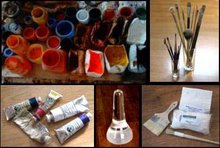Grinding Oil Paint
Like anyone, I have days when all I want to do is squeeze out some ready-ground paint and slap it onto a ready-primed canvas, but there is a lot to be said for learning to grind your own paint, especially for use with pigments that are no longer available in paint tubes.
The act of grinding paint achieves two things: firstly, it makes the pigment particles smaller, which improves the spread and intensity of the colours when applied as paint; secondly, it forces the particles firmly and permanently amongst the oil. This is not the same as simple mixing. You may feel you have achieved a paint-like consistency by mixing with the palette knife, but this it superficial and grinding is still required to prevent separation later on. As a general rule, the more grinding the better.
You will need:
A glass muller and slab (glass plate)
A palette knife
Powdered Pigments
Base Oil (e.g. linseed, poppy or walnut)
Paint tubes or Tin Foil, to store the paint
Basic Steps for grinding paint
Drop some powdered pigment onto the slab using a palette knife.
Gradually add drops of oil, blending with the palette knife until the paint is smooth and glossy but not runny (it should cling to the knife, when tipped on its side)
Taking a small amount at a time, use the muller to spread the paint thinly across the slab and rotate it over the paint in a brisk clockwise motion. At intervals, retrieve any escaping paint from the sides of the muller using the knife. If the paint becomes too liquid when ground. add a little more pigment to maintain the desired consistency
Continue to grind the paint in small amounts until the entire batch has reached a smooth, glossy consistency, with no ‘grainy’ noises audible during grinding.As a final step, scrape the entire batch into the centre and give it a brief grinding.
Tubing the Paint
Your paint can now be stored in tubes (or in tin foil for a shorter time). The following method of tubing paint is fairly low tech but it works for me...
Ease the paint into the tube using the knife, tapping the tube down firmly at intervals, to expel any air.
Using a rounded brush handle, flatten one side of the tube right down to the end, leaving a narrow airway down the other side of the tube.
Now flatten the tube firmly across the width and roll the brush handle down the length of the tune, allowing a small amount of paint to ooze towards the end. Allowing a little paint to escape is the best way to ensure that no air is trapped in the tube. (It is a good idea to catch the escaping paint in a piece of tin foil.)
Roll up the end of the tube and label your paint. The foil containing the overflow paint can be similarly labelled but won't last as long.
Choosing a Base Oil
- Linseed is fast drying & thicker than some other oils. It dries to a flexible film, but can yellow over time. Some feel that cold pressed linseed oil is better than refined linseed oil as it is slower to yellow, even though it may appear yellowish in colour. Linseed is particularly good for earth colours, blacks, alizarins & cadmiums.
- Walnut is slower-drying than linseed, thinner and less prone to yellowing. Leonardo used this oil exclusively, but it benefits from a hot climate to speed drying. It is less popular in Northern countries.
- Poppy is the thinnest and slowest drying of the three. It is best reserved for fast-drying pigments such as lead-based colours and vermillion. It is also useful for blues.
Some Hints on Grinding
- Oil consistencies vary, according to supplier, age and other factors. When grinding with thicker oils, you will generally use more oil and the paint will have a more ‘stringy’ consistency. With thinner oils, the paint is more buttery & will require less oil.
- Different pigments require different amounts of oil and different amounts of grinding. (‘The Materials of the Artist’ by Max Doerner contains useful advice on the properties of different pigments for grinding)
- Lead pigments such as flake white do not easily blend with the oil in the initial stages of grinding. To help with this, you can add a small amount of vodka or white spirit to the pigment and mix to a stiff paste with the palette knife before adding the oil. (The alcohol will evaporate fairly rapidly during grinding.)
- Some pigments (such as lead-based ones) will become increasingly liquid as they are ground. When this occurs, add additional powdered pigment at intervals during the grinding process, to achieve the desired consistency.

No comments:
Post a Comment